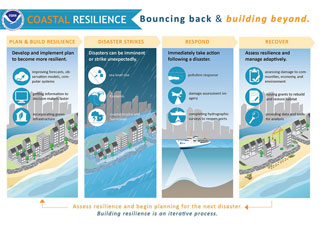National Ocean Service: Positioning America for the Future
Coastal watershed counties were home to 163.8 million people in 2010—approximately 52 percent of the U.S. population. This number is expected to increase by more than 15 million by 2020. Through NOS, NOAA is the lead federal agency responsible for promoting the sustainable, safe, and efficient use of our nation's coastal, ocean, and Great Lakes resources. NOS's science-based products and services are positioning America's coastal communities, economies, and ecosystems for the future of economic growth and environmental change. NOS has identified three priorities that reflect our statutory mandates and missions:

Coastal preparedness, response, recovery, and resiliency. In light of increasing threats to our coasts, NOAA's preparedness, response, recovery, and resiliency activities have become a national priority. From oil spills and vessel groundings to hurricanes and marine debris, NOS provides world-class science and services in support of healthy coastal communities, economies, and ecosystems.

Coastal intelligence. Whether it is the nation's nautical charts, environmental monitoring or socioeconomic tools, NOS and its partners integrate science and services to provide actionable intelligence. Informed decision makers, both public and private, are able to make informed choices on their use and stewardship of coastal resources.

Place-based conservation. NOS works to conserve marine areas and preserve economic benefits of special places through its coastal management and place-based conservation programs. NOS provides leadership for state and local coastal management efforts across the nation and is the primary conduit for data and services at NOAA to support informed coastal decision making. NOAA's national marine sanctuaries are America's primary instrument for place-based conservation of special marine places in offshore areas.
Fiscal Year 2015 Budget Request Highlights:
The FY 2015 President's Budget request for NOS is $519,412,000. NOAA's National Ocean Service is positioning America for a future of higher intensity coastal storms, increased demands on the marine transportation system, changing sea levels leading to coastal flooding, and heightened offshore and coastal development.
In FY 2015 NOS is making critical investments in products, services, and capabilities that will improve the resilience of the Nation's coasts to immediate hazards and long term risks, all of which are linked through complex relationships among geophysical features, ecosystems, and human activity. The program changes noted below are with respect to the FY 2015 Base (= FY 2014 Enacted + Inflationary Adjustments). Highlights include:
top
Mission Critical Infrastructure
- Shoreline Topographic/Bathymetric LIDAR (+ $4.0M) Working with interagency partners, NOAA will expand the initiative toward a national topographic/ bathymetric elevation dataset to inform navigation safety, coastal storm preparedness, and stewardship of ecological resources.
Services to Enhance Community Resilience
- Capacity to Respond to Extreme Events (+ $5.0M) In response to increasing frequency and intensity of coastal inundation events, NOAA will provide products and services that translate existing data and observations into actionable intelligence for state and local decision makers.
- Regional Coastal Resilience Grants (+ $5.0M) NOAA will establish a competitive grant program to promote coastal communities' resilience to extreme weather events and climate hazards. This funding will fill a gap in the current state-centric structure of the Coastal Zone Management Grants by prioritizing actions that bring together partners on a regional scale.
- Ecological Forecasting (+ $4.0M) NOAA's National Centers for Coastal Ocean Science (NCCOS) will develop and operationalize ecological forecasts for harmful algal blooms (HABs), hypoxia, pathogens, and species distributions.
- Coastal Ecosystem Research and Development (+ $6.0M) NCCOS will expand its competitive grant program to fund extramural research and applied science to inform decisions that are critical to the stewardship of ecological resources.
- Arctic Oil Spill Preparedness (+ $1.3M) NOAA will make investments to fill critical gaps in the nation's capabilities in the Arctic: oil spill modeling, identification of sensitive ecological resources, preparedness of local responders, and other science gaps.
Scientific and Programmatic Innovation
- Marine Sensor Innovation (+ $1.0M) NOAA will expand and accelerate the development and implementation of new marine sensor technologies to enhance the nation's understanding of coastal stressors, such as ocean acidification and ecological change.
top
In addition to these increases, the FY 2015 Budget request maintains robust support for NOS's partnership-based approaches to creating coastal intelligence, improving the resiliency of coastal and great lakes communities and economies, and employing place-based approaches to resource conservation.
 An official website of the United States government.
Here's how you know we're official.
An official website of the United States government.
Here's how you know we're official.




